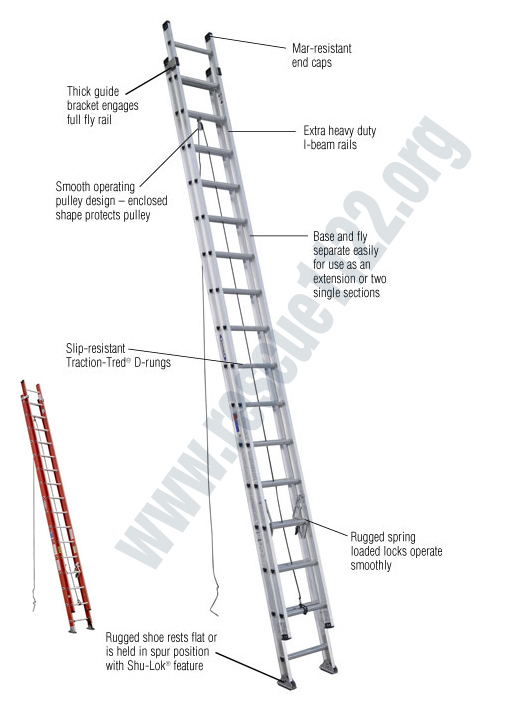About Fire Ladders:
After completion of the Fire Ladders lesson, you will be able to:
- Define the ladder.
- Describe the types of ladder.
- Describe the types and specifications of extension ladders.
- Describe proper care and maintenance of the ladder.
- Demonstrate the appropriate use of the ladder.
Introduction:
Ladders are very important in Fire service & Rescue work. The fire unit
is considered incomplete without Ladder.
1.1 History:
Ladders are used by human beings since life appeared on the earth and with the passage of time man made it a modem and modern. So it got the shape of an escalator and snorkel from a simple wood Ladder.
The simplest form of Ladder was used by a man when one person plucks the fruit by standing on the shoulder of the other person. Then man moved to the modern world and simple ladders have been shaped into modern ladders like escalators & snorkel.
1.2 Role of the Ladder:
To Save life.
To reach up to high building.
To get into deep places.
To Make bridge between two buildings.
To use as a stretcher.
Types Of Ladder:
- Short/first-floor Ladder.
- Hook ladder.
- Scaling Ladder.
- Extension Ladder.
2.1 Short /First-floor Ladder:
The first floor is normally used to extend the first floor or the first story of the building. It can also be placed on the Fire and rescue Vehicle. The first-floor ladder is normally used for ascending and descending the equipment and the person performing fire and rescue operations. It was made of wood, but now aluminum is used to make these ladders.
Specification:
LENGTH: 15 Feet.
WEIGHT: 45 Pound.
2.2 Hook Ladder:
It is also very important in the fire service. It is called the hook ladder because it has two hooks on the head side attached with the arms of the ladders. Therefore it can be easily hung with windows and other ventilation places. Lightweight, even only one fireman can use it.
Specification:
LENGTH: 13.6 feet.
WEIGHT: 30 Pound.
RUNGS DISTANCE: 11 Inches.
2.3 Scaling Ladder:
It is the shortest & lightweight ladder. It is used in narrow places.
Specification:
LENGTH: 6.6 feet.
WEIGHT: 20 Pound.
3. Extension Ladder:
Is the most important ladder in fire service because it can be extended easily.
Types:
- 30 feet extension ladder.
- 35 feet extension ladder.
- 45 extension ladder.
3.1. 30 Feet Extension Ladder:
Aluminum metal is used to make this ladder. It has two pieces of 16 feet & 6 inches each. The rope is used to extend it.
Specification:
Total length: 30 feet
Working length: 28-30 feet
Weight: 112 pound
Overlapping: 3-5 feet
3.2. 35 Feet Extension Ladder:
This extension ladder is normally used in the fire service. It is made up of wood and aluminum. It consists of two pieces of length. 21 feet each. Its working length is 35 feet & 7 feet is for overlapping to reduce elasticity.
Specification:
Total length: 42 feet.
Working length: 35 feet.
Weight: 130 pounds.
Overlapping: 7 feet.
33
3.3. 45 Feet Extension Ladder:
This extension ladder is made up of aluminum. It consists of three parts of 20 feet in length. It can be used up to 45 feet only because when we open its 15 feet length is used for overlapping. It becomes elastic due to its length. Therefore, its elasticity can be reduced by using two supporting poles.
Specification:
Total length: 60 feet.
Working length: 45 feet.
Weight: 300 pounds.
Overlapping: 7 1/2+ 7 1/2=15 feet.
Escalator:
It is normally used in Airports, Railway stations, and in modem buildings. It is automatic and electric and can run every time. It is easy to use we can just put our feet on the first step and it takes us up to the upper floor.
4. Care & Maintenance of ladders:
- The ladder should be checked before and after use.
- Do not put a heavyweight on it (when store).
- Prevent the ladder from rain, sunlight, and rust.
- Keep it clean from dust.
- Proper oiling and greasing check pulley & other parts for oiling.
- Do not use a ladder affected by acidic material.
5. Appropriate Use:
- Read instructions before starting the work.
- Electricity may be passed through its parts.
- Normally it should be operated by one person except during evacuating causality.
- Don’t put weight more than 350 pounds in it.
- The heel side of the ladder must be put on the plain area.
- Keep the head side up to 3 feet from the desired point.
- Use the safety belt while climbing up the ladder.
- Keep your face on the ladder while using the ladder. Hold the ladder firmly during work.

John Doe, a seasoned firefighter, shares his vast knowledge of fire safety and emergency preparedness at arescuer.com, aiming to empower and educate


Hello colleagues, how is the whole thing, and what you would like to say about this piece of writing, in my
view its genuinely amazing designed for me.